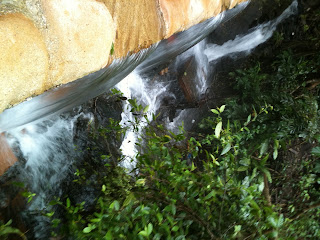Advice: Don't be shy with the sun screen. I've never had a worse sunburn in my life. (Though the accompanying tan was pretty nice ;] )
The beaches were filled with lots of surfers, and you could easily rent a surfboard for around $10 a day. If not, swimming and body surfing are a lot of fun too.
Advice: If you go to the beach, make sure you bring a towel you don't mind throwing away, or have enough time to let it dry thoroughly. I was amazed by how heavy my towel was after the beach, when it was soaking wet and covered in sand. This adds a lot of weight to a suitcase, and international flights usually have a 50 pound limit with a hefty overweight fee (I've heard it's around $200).
On these last days I took maybe my favorite picture from the trip during our ocean-side dinner.
 |
| I couldn't believe how beautiful this place was. It looked like something out of a movie. |
 |
| Sunset at the beachside restaurant was stunning. |
Our final dinner in Costa Rica was wonderful also. We each went around the group and told our favorite parts, and at the end we all received a superlative from our counselors.
After that we all traveled home, some vowing to return to Costa Rica, all knowing we'll never forget this trip.
One of the wonderful things about this trip is the Alumni Network that we all sign up for. It's an online social network specifically for GREEN, and lets everyone keep in touch after the trip. It's one of the things that makes the trip last past its twelve day duration.
On this last post I wanted to give out my final pieces of advice for the trip.
1. One thing to be aware of is how high the wind speeds get, especially noticeable at night. I thought there was a hurricane outside the first night I stayed because of how loudly the wind was howling. It's nothing to be afraid of, just something to be aware of. It's also one of the reasons wind power is so prevalent in Costa Rica.
2. There are animals everywhere. There are a lot of stray dogs running around, and also a lot of geckos that like to hang out in the hotels. I also found a handful of spiders in my room, and there are ants everywhere. If you're afraid of insects, this might not be the trip for you.
3. Bundle up at night. The nights in Costa Rica were surprisingly cold for the nice weather. Be aware that is does get cold at night and the hotels usually don't provide comforters like they do in the U.S.
4. The currency in Costa Rica is Colonas, but don't worry about converting your money. Almost all places take U.S. dollars.
5. The electrical outlets work just the like ones in the U.S., so you don't need to bring a converter.
I highly, highly recommend this trip. It was fun, adventurous and educational. You meet a group of smart, talented, motivated and exciting people whom you will never forget.
Wherever your travels take you, have fun!
































